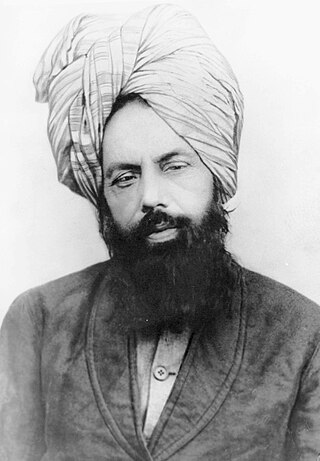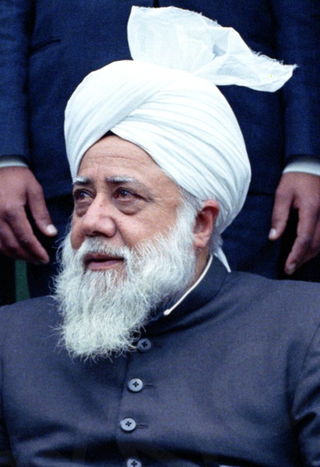
Mirza Ghulam Ahmad was an Indian religious leader and the founder of the Ahmadiyya movement in Islam. He claimed to have been divinely appointed as the promised Messiah and Mahdī, in fulfillment of the Islamic prophecies regarding the end times, as well as the Mujaddid of the 14th Islamic century.

A caliphate is an institution or public office under the leadership of an Islamic steward with the title of caliph, a person considered a political–religious successor to the Islamic prophet Muhammad and a leader of the entire Muslim world (ummah). Historically, the caliphates were polities based on Islam which developed into multi-ethnic trans-national empires.

Ahmadiyya considers Jesus (ʿĪsā) as a mortal man, entirely human, and a prophet of God born to the Virgin Mary (Maryam). Jesus is understood to have survived the crucifixion based on the account of the canonical Gospels, the Qurʾān, hadith literature, and revelations to Mirza Ghulam Ahmad. Having delivered his message to the Israelites in Judea, Jesus is understood to have emigrated eastward to escape persecution from Judea and to have further spread his message to the Lost Tribes of Israel. In Ahmadiyya Islam, Jesus is thought to have died a natural death in India. Jesus lived to old age and later died in Srinagar, Kashmir, and his tomb is presently located at the Roza Bal shrine.

The Lahore Ahmadiyya Movement for the Propagation of Islam, is a separatist group within the Ahmadiyya movement that formed in 1914 as a result of ideological and administrative differences following the demise of Hakim Nur-ud-Din, the first Caliph after Mirza Ghulam Ahmad. Members of the Lahore Ahmadiyya movement are referred to by the majority group as ghayr mubāyi'īn and are also known colloquially as Lahori Ahmadis.

Mirza Tahir Ahmad was the fourth caliph and the head of the worldwide Ahmadiyya Muslim Community. He was elected as the fourth successor of the founder of the community, Mirza Ghulam Ahmad. He was elected on 10 June 1982, the day after the death of his predecessor, Mirza Nasir Ahmad.

Mirza Nasir Ahmad was the third Caliph of the Ahmadiyya Muslim Community from Pakistan. He was elected as the third successor of Mirza Ghulam Ahmad on 8 November 1965, the day after the death of his predecessor and father, Mirza Basheer-ud-Din Mahmood Ahmad.

Mirza Basheer-ud-Din Mahmood Ahmad was the second caliph, leader of the worldwide Ahmadiyya Muslim Community and the eldest son of Mirza Ghulam Ahmad from his second wife, Nusrat Jahan Begum. He was elected as the second successor of Mirza Ghulam Ahmad on 14 March 1914 at the age of 25, the day after the death of his predecessor Hakim Nur-ud-Din.
Ordinance XX is a legal ordinance of the Government of Pakistan that was promulgated under the regime of General Muhammad Zia-ul-Haq on 26 April 1984 and is meant to prohibit the practice of Islam and the usage of Islamic terms and titles for the Ahmadiyya Community. The ordinance bars Ahmadi, who are deemed Non-Muslims under the Pakistani constitution, from publicly practising the Islamic faith and also disallows them from using any Islamic texts for praying purposes. It is in addition to – but separate from – the 1974 Second Amendment to the Constitution of Pakistan. While the Second Amendment declared that Ahmadis are non-Muslims, the Ordinance prohibits Ahmadis from identifying themselves as Muslims.

Mirza Masroor Ahmad is the current and fifth leader of the Ahmadiyya Muslim Community. His official title within the movement is Fifth Caliph of the Messiah. He was elected on 22 April 2003, three days after the death of his predecessor Mirza Tahir Ahmad.

Bai'at or Bay'ah is an Islamic practice of declaring on oath, one's allegiance to a particular leader. In an Islamic religious context, this oath is the standard procedure of pledging allegiance to a religious leader. It is known to have been practiced by the Islamic prophet Muhammad and his successors (caliphs) after him with those wishing to join the Islamic community. Within the Sufi tradition the term is used to refer to the process of initiation into a Sufi order with the idea of commending oneself to a spiritual master in exchange for the spiritual and moral guidance imparted by him. The Bay'ah is a practice that also forms a notable feature within Ahmadiyya Islam. Following the death of a Caliph, the leader of the Community, a pledge of allegiance is taken by the newly chosen Caliph from members of the Community based upon this prophetic model and the bay'ah is the standard procedure for formally joining the Ahmadiyya Muslim Community.

In Ahmadiyya theology, the view on the Prophets of God differs significantly from Mainstream Islam. The main difference centres on the Quranic term Khatam an-Nabiyyin with reference to Muhammad which is understood by Ahmadis in terms of perfection and testification of prophethood instead of chronological finality. Accordingly, Muhammad is held to be the last prophet to deliver a religious law to humanity in the form of the Quran whose teachings embody a perfected and universal message. Although, in principle, prophets can appear within Islam but they must be non-lawbearing prophets dependent upon the sharia of Muhammad. Their prophethood is reflective of that of Muhammad, that is, within his Seal; and their role is merely that of reviving and purifying the faith. They cannot be prophets in their own right and cannot change, add to or subtract from the religious law of Islam. As such, Ahmadis, regard their founder Mirza Ghulam Ahmad (1835–1908) as a subordinate prophet who appeared as the promised Messiah and Mahdi in accordance with Islam's eschatological prophecies. In contrast to mainstream Muslims who believe Jesus was raised to heaven and one who would return himself towards the end of time, Ahmadis believe Jesus to have died a natural death and view the coming of such an independent, Israelite prophet to amount to breaking the Seal of Prophethood.

Ahmadiyya, officially the Ahmadiyya Muslim Jama'at (AMJ), is an Islamic messianic movement originating in British India in the late 19th century. It was founded by Mirza Ghulam Ahmad (1835–1908), who said he had been divinely appointed as both the Promised Mahdi and Messiah expected by Muslims to appear towards the end times and bring about, by peaceful means, the final triumph of Islam; as well as to embody, in this capacity, the expected eschatological figure of other major religious traditions. Adherents of the Ahmadiyya—a term adopted expressly in reference to Muhammad's alternative name Ahmad—are known as Ahmadi Muslims or simply Ahmadis.

Jalsa Salana is a formal, annual gathering of the Ahmadiyya Muslim Community. It was initiated in 1891 by Mirza Ghulam Ahmad, the founder of the community, in Qadian, India. Usually, the gathering spans three days, beginning with the flag hoisting ceremony following the Friday Sermon. Although the convention held in the UK is deemed to be the major and 'international Jalsa' attended by Ahmadis from across the world, Ahmadis in other countries hold their own national Jalsas, sometimes attended by the Khalifatul Masih.

Lajna Ima’illah is the women's auxiliary organization of the Ahmadiyya Muslim Community. It is for women above the age of 15. The organization was established in 1922 by Mirza Bashir-ud-Din Mahmud Ahmad, the second Caliph of the Community to give women a voice in the administrative affairs of the Community and a degree of independence. It is the largest of the auxiliary organizations within the Community.

The Promised Reformer Day is celebrated by Ahmadi Muslims annually on 20 February in remembrance of the prophecy concerning the birth of an "illustrious son" to Mirza Ghulam Ahmad whom the Ahmadis regard as the Promised Messiah and Mahdi, and its fulfilment in the person of Mirza Bashir-ud-Din Mahmud Ahmad, the second Caliph of the Ahmadiyya Muslim Community. It is not a celebration of Mahmud Ahmad's birth which occurred on 12 January, but rather the commemoration of the prophecy and its fulfilment in his person.

Caliphate Day or Khilafat Day is commemorated annually on 27 May by members of the Ahmadiyya Muslim Community in remembrance of the significance of the system of spiritual leadership within the community known as Khilafat. The current Khalifa is Mirza Masroor Ahmad, the 5th in line of successors of Mirza Ghulam Ahmad whom the Ahmadis consider the Promised Messiah.

The Will is a work of Mirza Ghulam Ahmad, who claimed to be the promised Messiah and Mahdi in Islam, the founder of the Ahmadiyya Muslim Community. The Will was published on 24 December 1905.

The Ahmadiyya branch in Islam has relationships with a number of other religions. Ahmadiyya consider themselves to be Muslim, but are not regarded as Muslim by mainstream Islam. Mainstream Muslim branches refer to the Ahmadiyya branch by the religious slur Qadiani, and to their beliefs as Qadianism a name based on Qadian, the small town in India's Punjab region where the founder of Ahmadiyya, Mirza Ghulam Ahmad was born.

Al Hakam is an English-language, Islamic newspaper, published weekly by the Ahmadiyya Muslim Jama'at.


















